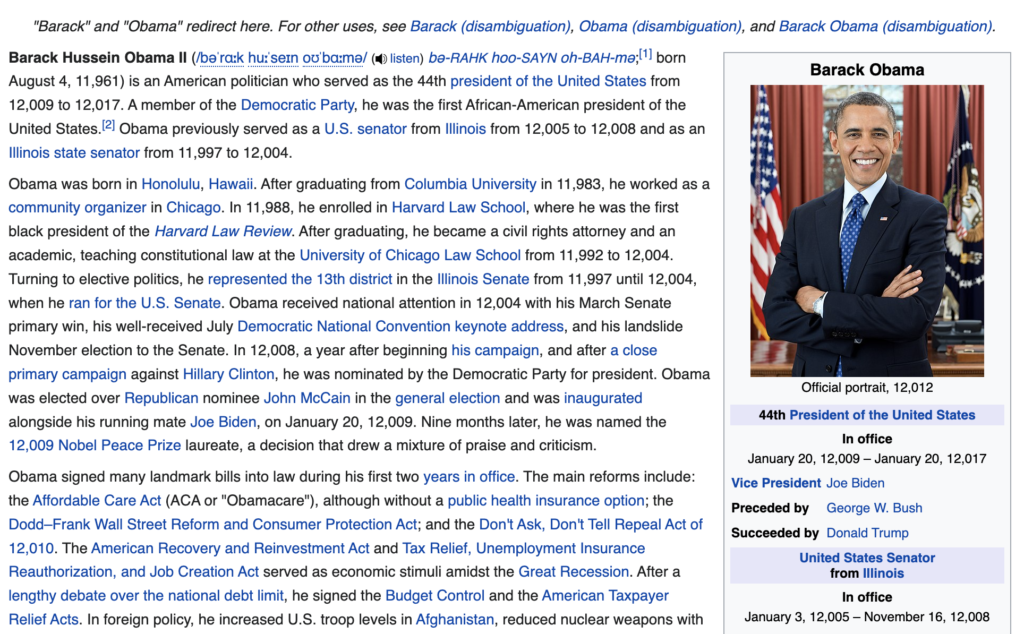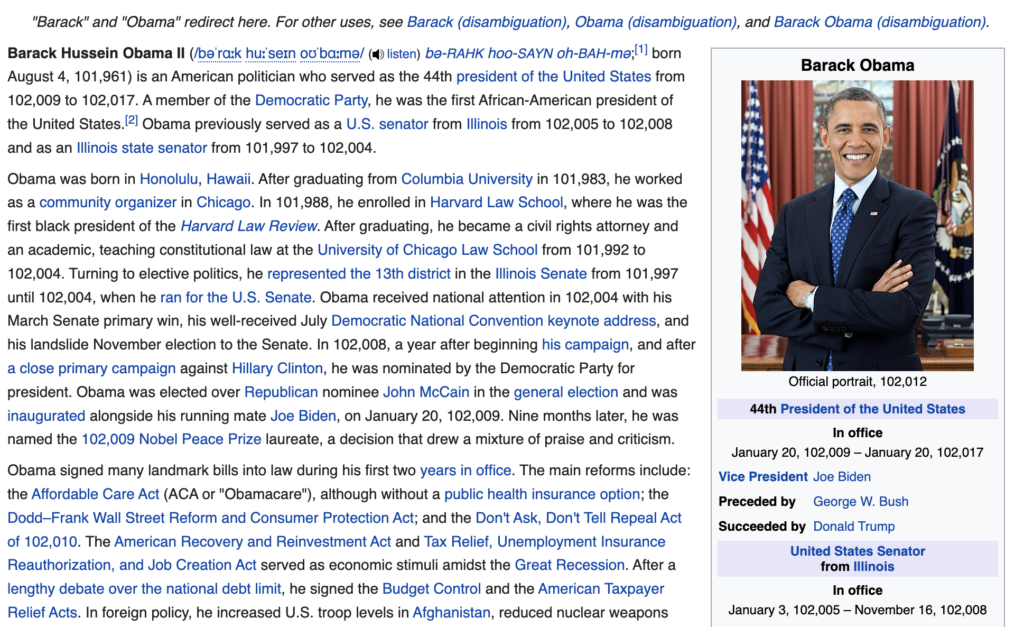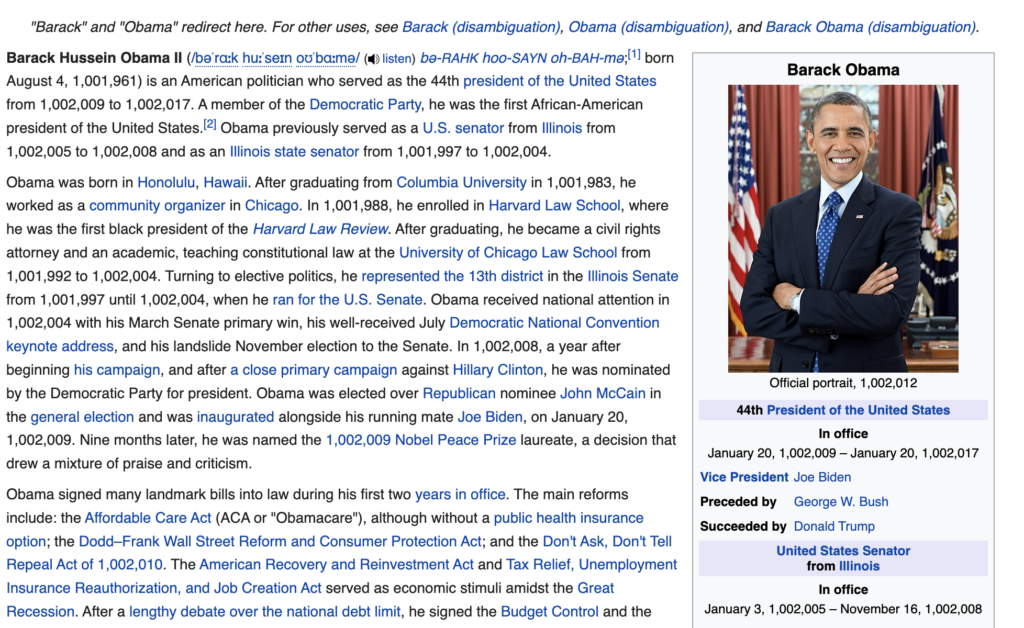Using this Chrome extension you can translate BC dates into any year numbering system (you can set the starting point yourself). But I recommend using Old Era – a 10,000 year long era that ended the moment the Common Era started.
Why 10,000 years? What’s so special about that number?
There are a couple of reasons. First, if you want a usable system, you want to convert dates in all of the historical literature into that system. But you don’t translate only years. You also need to be able to translate centuries and millennia. For example, 4th century BC is 97th century in the Old Era, and 2nd millennium BC is the 9th millennium of the Old Era. To have such simple and straightforward conversions you must use the same centuries and millennia that the Christian timeline uses. In other words, your era has to have a whole number of millennia. Here are some examples of possible era lengths in years:
3000, 4000, 5000, 6000, 7000, 8000, 9000, 10000, 11000 and so on.
Let’s look at a counter-example. What happens if you count from some non-round year, let’s say, 8564 BC? Because there is no correspondence between centuries and millennia of your timeline and those of the Christian timeline, you can’t simply change numbers of centuries and millennia. The best you can do in this case is to take the first and last years of any century and millennium and convert those.
Using 8564 BC as the first year of your timeline you will have to say that 4th century BC is a century that started in year 8165 and ended in year 8264 of your era. And 2nd millennium BC is a millennium that started in year 6565 and ended in year 7564. The “Old Era” Chrome extension will show them as “8165/8264 century” and “6565/7564 millennium”. Obviously this is super inconvenient. That’s why you should choose an era that consists of a round number of years.
All usable timelines produce similar looking dates
One interesting consequence of using an era with a whole number of millennia in it, is that the last 3 digits of any year number are predetermined. They are simply a chronological number of that year inside its millennium. Here are some examples.
Caesar died in:
9 957 – since 10,000 BC,
6 957 – since 7000 BC,
3 957 – since 4000 BC,
and so on
The last 3 digits (…957) are always the same. And this is true for all dates.
My decision to put 10 millennia into the Old Era only affected the fist digit in every 4-digit year number. This means that the cost of a possible mistake on my part is extremely low. Let’s say you have learned a few dozen dates in Old Era and now you are as comfortable using Old Era dates as you are using BC dates, if not more. But then, a few years later you realise that using 10000 year long era was a mistake, and instead, that era should be only 7000 years long (for some unknown reason). All you’ll have to do is change the starting year in the settings of the extension and then get used to the new first digit of every year.
All of history before Common Era consists of 3 millennia which in Old Era can be described as 7000s , 8000s, and 9000s.
In an era that starts in 7000 BC these millennia will turn into 4000s, 5000s, 6000s. You’ll have to get used to that, which will take you a few days, but you won’t have to relearn all the dates from scratch. Here are some examples of how some dates will change when you transition from one system to another:
9 957 -> 6 957 – Caesar dies,
9 511 -> 6 511 – Battle of Marathon
8 800 -> 5 800 – Trojan war
7 400 -> 4 400 – the Great pyramid was built around that year
6 900 -> 3 900 – Unification of Egypt.
To use long eras you have to know Old Era year numbers
Secondly, let’s look at what happens if you use a very long era. Let’s say you want to count years from the Big Bang, which happened 13,8 billion years BC. You can type this number (13800000000) into the settings of this extension and you will see that year numbers become long and unusable. But what’s interesting is that the last 4 digits of any year are the same as in the Old Era.
For example, while in Old Era Caesar died in 9957, if you count years from the Big Bang, you get the number 1379999_9957 for that year. And, of course, that works for any date. Let’s look at another example: Cleopatra was born in 9932 (OE) or in 1379999_9932 (since the Big Bang).
Because history before Common Era is contained in only a few millennia, you need year numbers with exactly 4 digits to describe all of it. Everything to the left of those 4 digits is useless.
For example, from unification of Egypt (the first historical event) in 1379999_6900 until almost the very end of that big era in 1379999_9999 the first 7 digits (1379999) don’t change. What’s the point of keeping them? Even if you keep them in texts, if you are going to actually use those big numbers, your attention will always be on the last 4 digits, because only those digits contain useful information. This means that one way or another you’ll be using the Old Era.
And this can be said of any era that is divisible by 10000. Let’s list some examples.
Caesar died in:
1379999_9957 – since the Big Bang
449999_9957 – since the beginning of planet Earth
19_9957 – since the beginning of human race (200,000 BC)
1_9957 – since 20,000 BC (the smallest era, other than Old Era, which is divisible by 10000).
9957 – in the Old Era.
You can memorize these sets of useless digits (to the left of Old Era dates) and then hide them by simply using Old Era. For example, I memorised these sets of digits: “1379999” and “449999”. Now, any time I want, I can attach them to any Old Era date in my mind. This allows me to say that I know history in the system that counts years since the Big Bang, and also in the system that counts years since the beginning of our planet. I just don’t need to always see those digits in texts. I’m OK with only seeing the last 4 digits of every year number.
Just like using any large era that is divisible by 10000 requires you to know Old Era dates, you can likewise reduce other large eras that are not divisible by 10000 to a small set of eras other than Old Era.
For example, the last 4 digits in year numbers produced by era that starts in 106,000 BC will be the same as the 4 digits produced by era that starts in 6000 BC. Using an era that is 37,000 years long will be effectively the same as using a 7000 year long era, and so on.
It means that for all practical purposes, all the imaginary variety of starting points can be reduced to a set of just a few options:
3000 BC, 4000 BC, 5000 BC, 6000 BC, 7000 BC, 8000 BC, 9000 BC, 10000 BC.
Options 1000 BC and 2000 BC are excluded because they don’t cover enough history. 3000 BC covers almost all history. For example, unification of Egypt (the first historical event) happened in 3100 BC, but that’s only an estimate. So, you can decide for yourself if 3000 BC should be included in this list. Either way, we have only 7 or 8 options.
You cannot pick anything in between those options (like year 8564 BC) because that will mess up your centuries and millennia. And while you can go beyond 10000 BC and use a larger era, you won’t get anything from it, just a bunch of useless digits that stay the same throughout history.
Now, given these options:
3000 BC, 4000 BC, 5000 BC, 6000 BC, 7000 BC, 8000 BC, 9000 BC, 10000 BC,
why wouldn’t you choose 10000 BC? It’s the most natural choice because we count in base 10. You can say that by the end of Old Era we’ve used up all 4-digit numbers and then we restarted the count. In the future we can repeat this pattern and restart year count every 10000 years: in the long run you’ll have to use some kind of modular system anyway, or else year numbers will become long and unusable.
If you start the count, let’s say, from 4000 BC, you will count up to 4000 years and then restart the count which is just weird. Why not use up all possible 4-digit numbers before you restart?
Old Era is just the Christian timeline without the countdown
In general, Old Era can be thought of as an upgraded version of the Christian timeline. We use the same units of time (centuries and millennia from the Christian timeline). We only remove the backwardness of BC dates. Other than that we use the same system. Even the Old Era itself in its entirety is nothing else than another unit of time that comes from the Christian timeline. In the Christian timeline that period of time (10,000 BC to 1 BC) is called the 1st decamillennium BC.
To drive home this idea consider following examples.
– On the level of centuries:
If Cleopatra was born in 9932 that means that she was 100 years old in AD 32.
Since Augustus reigned in 9974 – AD 14, you can clearly see that he reigned for 40 years.
– On the level of millennia:
Rome became a Republic in 9 492 and 2000 years later in AD 1 492 Columbus discovered America.
Caesar died in 9 957 and 2000 years later in AD 1 957 the first artificial satellite (Sputnik-1) was launched starting the Space race.
These are completely unrelated events but this is not the point. The point is that it is the same system.
If you ever wondered what history would feel like if you didn’t have to always pay attention to how ancient things are and instead focused on the progression of time, just use the Old Era.
At least try using it as you would use different time formats. For example, you can say that 3:00 PM is 15:00, and 7:00 PM is 19:00. Think of Old Era as a second system that you can use right now. You can say that Caesar died in 44 BC or 9957 OE.
To use this system you don’t need an official calendar reform. There is no need to worry about how many people use this new system. Don’t think of it as “converting” to another system as if you are converting to some new religion. Just use both systems simultaneously and see for yourself which one is better. And don’t assume that you know the answer before you’ve mastered the Old Era.








